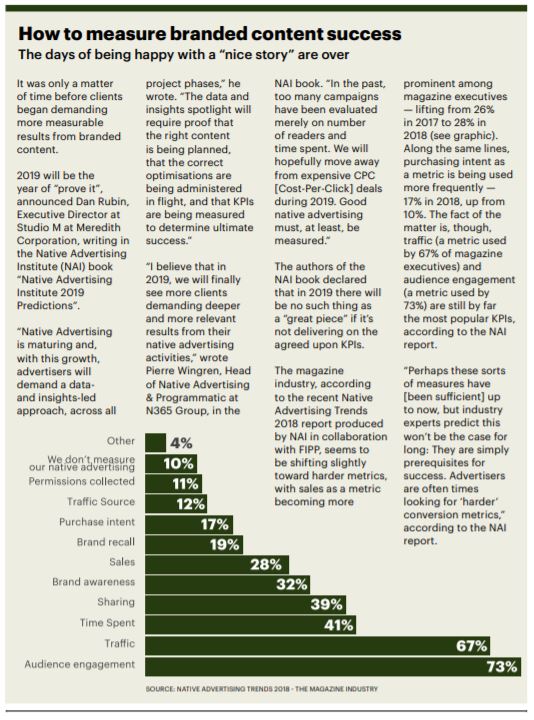
03 Oct How to ride a winning horse… (Even if it isn’t as easy as it looks)
Branded content that packs a punch
If there is a sure-bet in media today, it is that content marketing is exploding. It also appears to be a horse you could ride for some time, with healthy branded content growth projected until at least 2021, and perhaps beyond.
Beyond that, it also happens to be the one horse still running in a race where every other pony has pulled up lame. All other forms of advertising are shrinking.
“What’s the new currency of advertising? It’s content,” wrote former Folio Vice President Tony Silber in Forbes. “Ad spend is declining across the media industry — except in content marketing.
“From native posts to ebooks and even lush print magazines, the [content marketing] form is booming,” Silber said. “In fact, the global content marketing industry will grow at an annual rate of 16% per year through 2021, reaching US$412 billion by the end of 2021, according to a report published last November [2018] by the British market-research firm Technavio.”
Native will make up 76% of digital spend by 2021, according to Business Insider.
That growth is driven in no small part by the fact that 86% of business-to-consumer (B2C) brands now employ content marketing, according to the Content Marketing Institute. Publisher branded content revenue is also growing, up 40% year-on-year from 2017 to 2018, according to research by branded content platform Polar. Seventy percent of advertisers are shifting to content marketing, and 35% of publishers in 2017 already had a brand studio, according to American Chemical Society’s Chemical & Engineering News Senior Content Editor Jeffrey Lee.
Content marketing is “the only marketing left,” digital marketing pioneer Seth Godin told the Content Marketing Institute. It is authentic, useful, and perfectly suited for the internet generation, he said. Behind the statistics are a lot of high-profile branded content success stories like those of The Guardian, Quartz, and the New York Times.
Revenue from Guardian’s content studio, Guardian Labs, rose 66% in the first half 2018, compared to the first half of last year, according to The Guardian. The average value of The Lab’s larger deals (in excess of US$130,000) increased by 36%, according to the company. Guardian Labs client retention rates increased as well, but the company did not break out actual numbers. The results of the Lab’s work were also impressive: The average reader spent 2.3 minutes with Labs content, and in some cases, that number was as high as six minutes, according to The Guardian.
Launched in 2013, the Quartz branded content studio, also called The Lab, has created 540 campaigns for more than 150 brands and boasts a renewal rate of 90%, nearly three times the industry average, according to MediaRadar.
And the New York Times, which makes US$500 million globally, has nearly doubled its international digital ad business in the last two years and much of that growth has come from its in-house agency T Brand Studio, according to The Times.
All of that makes branded content sounds like the easiest, surest way to make money in media these days. But it ain’t. It’s a lot harder and a lot more expensive than it looks.
“Here’s the thing about good content creation, and maintaining audiences for it over time: It’s hard. It’s really hard,” wrote Rob Gregory, President of Sales and Marketing of WhoSay, an influencer marketing agency.
“Great branded content is really tough,” said Brian Tolleson, Head of Content at branded content studio BARK BARK, writing on AgencySpy. “I’ve been in this space for over fifteen years and the biggest mistake I’ve made, or seen other people make, is thinking that it’s simple: That if you just build the right machine and rent a cool space in Brooklyn, you can churn out effective branded content.
“We’ve told ourselves that we can build internal brand studios with a bunch of new college grads with laptops who don’t have much content experience or knowledge of diverse storytelling genres,” Tolleson wrote. “We pat ourselves on the back each and every hour of the day, thinking we can just ‘make stuff’ and everyone will watch it and love it — voluntarily! “This is not how content gets made. At all,” Tolleson wrote. For all the success stories, there are other media studios facing high content creation and distribution costs, and all of that in the face of dramatically increasing competition.
Many media studios are loaded with expensive writers and equipment in order to satisfy the clients’ (and readers’) expectations of high-quality content that looks and feels like the professional journalism of the editorial staff.
Branded content campaigns require multiple steps of approval, complicating and extending the process. Clients and agencies alike are demanding top-notch, multimedia content suitable for both the publisher’s site as well as for social media and websites outside of the publisher’s platforms.
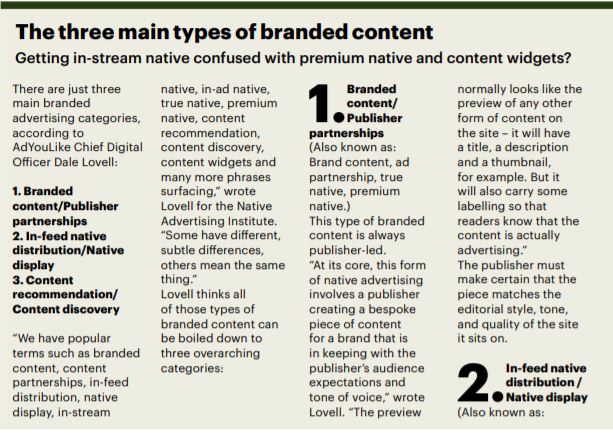
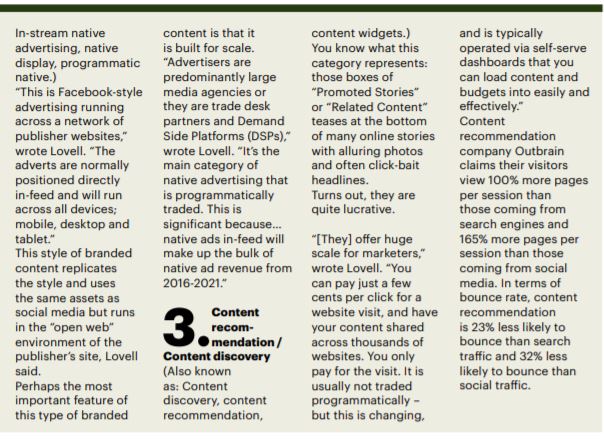
It’s really about the margin
“If running a display ad on your own site is nearly all profit, the margin on a branded content campaign could easily be half that”, Paul Rossi, President of The Economist Group, told Digiday. “If you look at the real challenge of native advertising, it’s really more about the margin than the revenue,” Rossi said.
To make matters worse, or at least more difficult, the siren song of branded content has prompted many media companies to open studios, exponentially increasing the competition and driving prices down. In a very short span of time, the number of publishers who have created branded content studios exploded from 15 in 2013 to 218 sites in 2015, to more than 600 in 2017, and more than 1,000 in 2018, according to research by ad tracking company Media Radar.
“Here’s the thing: While creating great content might look easy, it’s not,” wrote Google Editor and Content Strategist Stéphanie Thomson on Medium.com. “And just as people will hate your brand if you bombard them with annoying ads, they’ll feel exactly the same if you waste their time with crap, self-serving content.”
So, how do you avoid the crap and deliver the caviar?
The right team with the right skills sets
The best branded content is not the result of a single genius. It comes from the teamwork of a diverse group of people from all segments of publishing: editorial, marketing, tech, and sales.
“When it comes to building a winning content marketing team, you really are blending at least two fields: your traditional advertising creative and your journalist,” Atlantic Re-Think Creative Director Jeremy Elias told Thomson.
“We’ve got people who were editors at media companies, others who were documentary film-makers, and others who were copywriters at ad agencies,” Elias said. “It’s the merging together of their expertise that helps us create award-winning branded content.”
At the Guardian, each project is assigned to a core, four-person team with representatives from sales, strategy, editorial, and project management skills. They can use others on the Lab’s staff, but the ultimate responsibility is theirs.
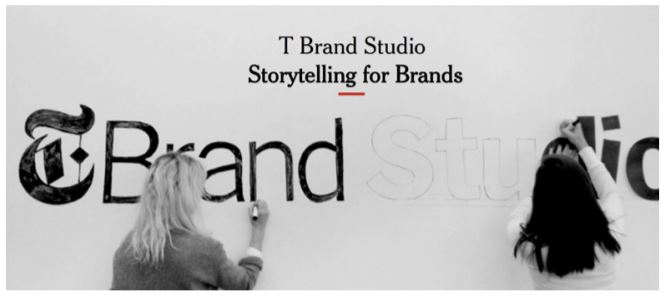
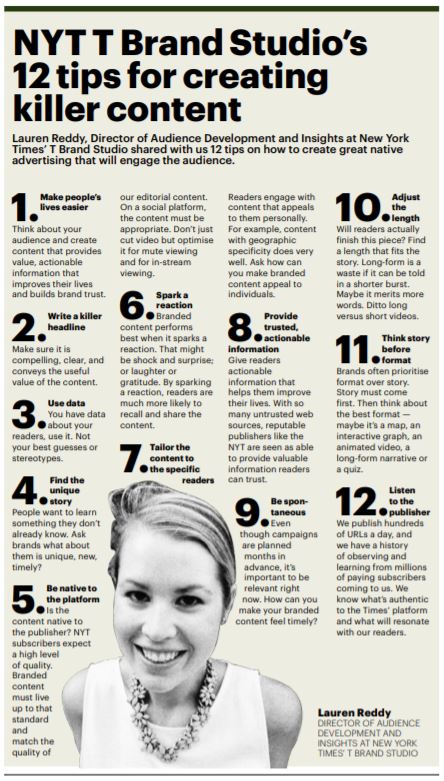
Tell the right stories
Going back to the aforementioned concern over “crap” content, it is a trap that is often hard to avoid because brands still want to sell products instead of telling a compelling story that is useful for the reader.
“Over time, we have found what works and what doesn’t,” T Brand Studio Creative Director Graham McDonnell told Mobile Groove Founder Peggy Anne Salz for a story on Digital Content Next. “Over time, we’ve seen that we have much more time spent on our content than on the content given to us by brands.
“We get brands coming to us saying, ‘We have this video of our CEO. He’s very engaging. It’s 32 minutes long. We just want to put it out there, and you don’t need to do anything with it. Just put it up and people will love it.’”, McDonnell said. “My response is, ‘No, that might not be the best idea.’ You have to put the brand message in a story people will like.”
“In some situations, the content really over-emphasizes the brand and makes it all about them. That can end up sounding like a repurposed press release,” Elias said. “It’s also possible to fall short on the other side of the equation, where you’re telling a really great story but there’s no connection to the brand. The idea is to fall in the middle, where your content provides value to the audience while also having a clear brand connection.”
Resist the siren song of bright shiny new things
“Some clients come to us and say they want AR or VR,” McDonnell said. “They want all the bells and whistles and all the flashy toys. But we tell them it’s much more important to think about the story first, and then how to tell it.”
Those bright shiny new things can “blind you to the core tenets of content marketing: What is the story, what is its value to the reader, and what is its value to the brand? That needs to come first,” McDonnel said. “Once you’ve answered those questions, then you get to have the fun conversations about the technologies you can use to bring the concept to life.”
Maintain the church-state divide?
At Refinery29, all branded content used to be created through their content studio. Not anymore.
Media companies like Condé Nast, Mental Floss, Dennis Publishing, and Refinery29 are all enlisting editorial staff in the creation of branded content.
Refinery29 may be going the furthest. They offer advertisers the opportunity to create influencer campaigns featuring sponsored posts written by Refinery29 editorial staff because the clients recognised that the company’s staffers are powerful influencers in their own niches. And the clients demanded access to those internal influencers.
So, starting in July 2017, Refinery29 began offering advertisers the opportunity to market their products and services directly to the editorial staff. Picking up on the recent mania for pop-up stores, Refinery29 allowed advertisers to get their products into the hands of its journalists through in-office Refinery29 “Pop-Ins”.
The client sets up displays in the event space right next to the Refinery29 editorial offices. Then, lured with free cocktails or other enticements, journalists (who range from writers to video producers to video talent) visit the PopIns to try everything from doughnuts to beauty products. Then they write about the products on their own platforms such as Instagram.
The staffers are not forced to participate, and they are paid a fixed (but undisclosed) fee per post via a quarterly bonus. Apparently, it’s working. Refinery29’s clients running native ads grew 76% year over year in 2017, according to MediaRadar data.
That wouldn’t play at the NYT. “We obviously can’t use journalists from the newsroom,” T Brand Studio Creative Director Graham McDonnell told Mobile Groove Founder Peggy Anne Salz. “There is quite a clear divide between the newsroom and advertising; it’s very much church and state.
“However, the studio is staffed with fully qualified journalists, many of whom have come from our competitors,” McDonnell said. “So, we have the strength of a newsroom, in integrity, and talent, and we leverage this for our advertisers.
Invest in data insights to inform campaigns
Agencies, advertisers, and smart content studio teams are using data-driven audience insights to take a lot of the guesswork out of campaign decisions. Those data can help teams decide which topics are shaping and driving audience interests and behaviours and how best to tap into those interests and behaviours to create successful campaigns.
“Any content studios that invest in insights are therefore a cut above,” Essence VP of Content and Innovation Laura Wade told Digiday. “Guardian Labs is further ahead on this than most, she added.
“Every Labs project is designed to resonate with and target readers wherever they may expect to see a type of content,” according to Guardian Labs Director of Sales and Strategy Adam Foley speaking to Digiday. “That’s partly thanks to the commercial team getting access to in-house data-analytics tools, like Ophan, long used by the Guardian’s editorial team.”
Guardian Labs also hired three commercial audience editors who analyse data to determine sweet spots for where, when and how content should appear in order to be of interest to the right target audiences, on and off site, Foley said.
So, is branded content for you?
Well, we all know that display advertising isn’t coming back. We also know that digital subscription sales, while growing, aren’t yet replacing lost ad revenue.
So, if you still want to support your media business with anything other than reader-driven revenue (think events, memberships, donations, e-commerce), branded content is clearly the best choice.
At least until the next bright, shiny new thing comes along!
